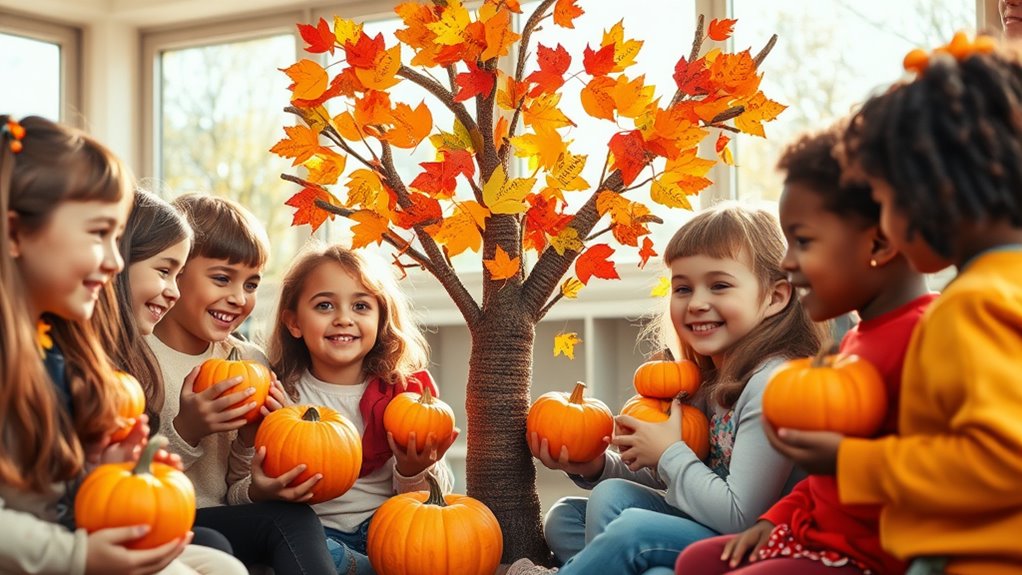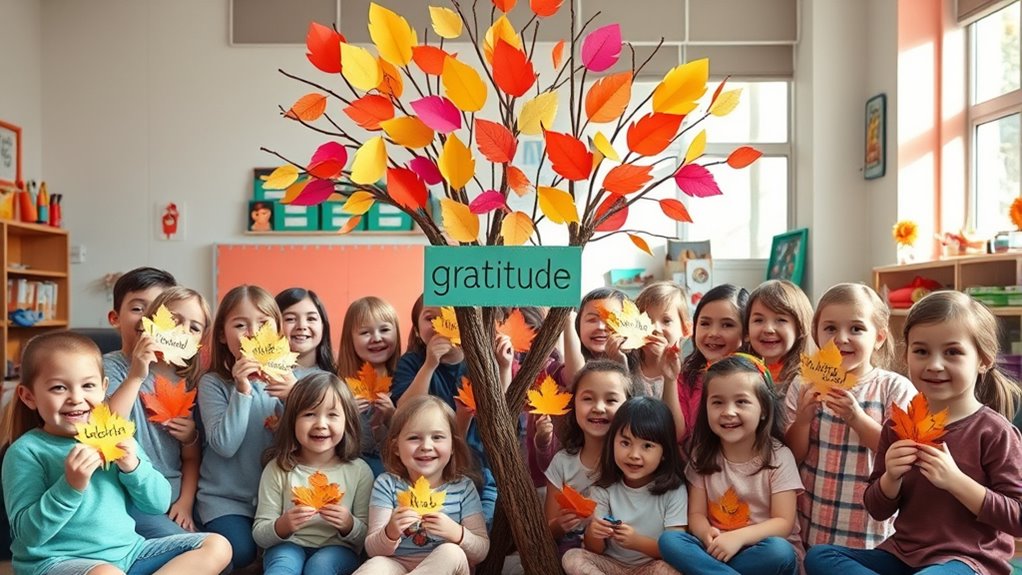To teach kids about thankfulness at Thanksgiving, involve them in meaningful discussions about gratitude, encouraging sharing and reflection through journaling or storytelling. Use fun activities like crafting thank-you cards, creating gratitude trees, or playing gratitude scavenger hunts to keep them engaged. Incorporate family traditions such as expressing thanks at meals or acts of kindness, which help reinforce appreciation. Keep exploring ways to make gratitude a natural part of their lives by trying more creative ideas.
Key Takeaways
- Engage children in gratitude discussions through open-ended questions and storytelling to foster understanding and appreciation.
- Incorporate creative activities like thankfulness crafts, journaling, and songs to make learning about gratitude fun.
- Integrate gratitude into family traditions such as sharing thankful notes, meals, and acts of kindness.
- Use art projects and outdoor activities to help kids identify and express what they are thankful for.
- Promote spontaneous acts of kindness and reflection to cultivate a genuine thankful mindset during Thanksgiving.
Engaging Children in Gratitude Discussions

To help children genuinely understand gratitude, you need to actively involve them in meaningful conversations about thankfulness. Start by encouraging thankfulness discussions where they share what they appreciate, helping them recognize the good in their lives. Incorporate gratitude journaling by prompting kids to write down things they’re thankful for each day, which reinforces their awareness of gratitude. During these conversations, ask open-ended questions like, “What made you happy today?” or “Who helped you recently?” This approach makes thankfulness more tangible and personal. Additionally, understanding the importance of color accuracy in visual experiences can help children appreciate the beauty of images and scenes they see, making gratitude for sensory details more meaningful. By engaging children in regular dialogues about gratitude, you foster a positive mindset and help them develop a genuine appreciation for the world around them. Consistent practice creates a solid foundation for a lifelong grateful attitude.
Creative Ways to Express Thankfulness

Finding creative ways to express thankfulness can make gratitude more meaningful and fun for kids. Encourage them to start gratitude journaling, where they write down things they’re thankful for each day. This helps them focus on positive experiences and develop a grateful mindset. You can also introduce thankfulness songs, which make expressing gratitude lively and memorable. Singing songs about gratitude during family gatherings or daily routines can reinforce appreciation in an engaging way. Creative activities like drawing thankfulness posters or making thank-you cards also inspire kids to share their gratitude visually. Incorporating cultural traditions such as traditional breakfast foods or celebrations can further enrich their understanding of gratitude across different communities. These methods turn gratitude into a playful, meaningful practice that kids look forward to, helping them understand and express thankfulness in ways that resonate with them.
Incorporating Thankfulness Into Family Traditions

Incorporating thankfulness into family traditions helps children see gratitude as a natural part of everyday life. You can do this by weaving gratitude into your family meal traditions, such as sharing what you’re thankful for before eating. Creating a gratitude journal with prompts encourages kids to reflect on their blessings regularly. To make it engaging, try these ideas:
Incorporate gratitude into family traditions with shared meals and fun journaling to nurture appreciation daily.
- Include a gratitude moment during family dinners
- Use gratitude journal prompts to inspire daily entries
- Start a yearly gratitude tree where everyone adds leaves with thankful notes
- Celebrate “Thankfulness Thursdays” with special activities
- Share stories of gratitude from family members during gatherings
These small, consistent practices help your children develop a genuine appreciation for what they have, making thankfulness a meaningful part of your family culture. Incorporating well-being tips such as mindfulness and reflection can further enhance their emotional growth and gratitude.
Fun Activities to Teach Appreciation

You can make learning about gratitude fun with simple activities like creating gratitude craft projects that let kids express what they appreciate. A thankfulness scavenger hunt also encourages them to notice and be thankful for small blessings around them. These activities turn appreciation into an engaging and memorable experience for children. Incorporating materials needed for craft projects can help children get hands-on and creative during these activities.
Gratitude Craft Projects
Creating gratitude craft projects offers a hands-on way to help kids understand and express appreciation. By making personal gratitude journals or thankfulness photo albums, children actively reflect on what they’re thankful for. These projects encourage kids to identify positive aspects of their lives and share their feelings creatively. You can guide them to decorate journals with drawings, stickers, or quotes that symbolize gratitude. For thankfulness photo albums, gather pictures that remind them of special moments or people. Other ideas include crafting gratitude jars, where kids drop in notes of thanks, or creating thank-you cards for loved ones. These engaging activities foster mindfulness and appreciation, making thankfulness a fun and meaningful part of their daily lives. Paying attention to credit card security during these activities can help teach children the importance of safeguarding personal information.
Thankfulness Scavenger Hunts
Thankfulness scavenger hunts turn appreciation into an exciting outdoor adventure that kids will love. Take them on a nature walk, encouraging them to find objects like colorful leaves, unique rocks, or flowers that remind them of things they’re grateful for. As they discover each item, have them add it to their gratitude journal, writing a sentence about why it makes them feel thankful. This activity helps children connect with their environment while reflecting on gratitude. You can create a list of items to find or let them explore freely, fostering curiosity and mindfulness. After the hunt, discuss what they found and why it’s meaningful, reinforcing the importance of appreciating everyday blessings in a fun, memorable way. Incorporating an understanding of Halloween traditions can also add a festive touch to your gratitude activities during the fall season.
Reading Books That Highlight Gratitude

Reading books that highlight gratitude offers a wonderful way to teach kids about appreciating the little things in life. Through engaging stories, kids can learn the value of thankfulness and develop a positive outlook. You can encourage gratitude journaling afterward to help them reflect on what they’re thankful for each day. Sharing thankfulness stories also inspires kids to recognize everyday blessings. Look for books that feature characters expressing gratitude in meaningful ways. Here are some ideas to enhance this experience:
- Choose stories with relatable characters demonstrating thankfulness
- Discuss the story’s message and relate it to your child’s daily life
- Use gratitude journaling to reinforce lessons learned from the book
- Read aloud together to foster connection and understanding
- Encourage your child to share their own thankfulness stories after reading
- Highlight how cybersecurity measures like strong passwords and encryption help protect people from digital threats, illustrating the importance of gratitude for safety and security in our lives
Encouraging Acts of Kindness and Giving

Encouraging acts of kindness and giving helps your kids see the value in helping others. Simple gestures, like sharing toys or performing random acts of kindness, can make a big impact. When you promote these behaviors, you’re teaching them to be caring and generous every day.
Random Acts of Kindness
Performing small acts of kindness can make a big difference in your community and help kids understand the importance of giving. Random kindness and unexpected generosity teach children that even tiny gestures matter. These acts can brighten someone’s day and foster a sense of gratitude. Encourage your kids to look for opportunities to help others, whether it’s holding the door open or sharing a smile. By doing so, they learn that kindness isn’t planned — it’s spontaneous and genuine. These small acts promote empathy and reinforce the spirit of Thanksgiving. Plus, they show kids that giving doesn’t always require money; kindness is free and powerful. Engaging in acts of kindness can also help children develop a positive outlook on life and build stronger relationships with others.
Sharing and Giving
Sharing and giving are powerful ways to show kindness and make a positive impact on others. When you encourage your kids to share meals or donate toys, they learn the joy of helping. You can create a simple table to illustrate acts of kindness:
| Sharing Meals | Donating Toys | Acts of Kindness |
|---|---|---|
| Family dinner | Toy drive | Compliment someone |
| Snack sharing | Shelving donations | Help with chores |
| Food at school | Giving away clothes | Write a thank-you note |
This visual helps kids see different ways to give. By involving them in sharing meals or donating toys, you teach them generosity and gratitude, making thankfulness a natural part of their lives. Low light office plants like Peace Lily or Snake Plant can also serve as a reminder of growth and nurturing in their journey of kindness.
Using Art and Crafts to Celebrate Thankfulness

Using art and crafts is a wonderful way to help kids express their gratitude creatively. You can encourage them to make thankful banners, gratitude jars, or personalized thank-you cards. Incorporate activities like color mixing to create vibrant fall-themed artwork that symbolizes gratitude, or teach paper folding techniques to craft leaves and turkeys. These hands-on projects make the experience more memorable and meaningful. Kids enjoy experimenting with colors and textures, which helps them reflect on what they’re thankful for. Plus, creating tangible tokens of appreciation reinforces positive feelings and gratitude. Considering electric bike conversion kits can inspire conversations about modern transportation and environmental gratitude, making gratitude fun and engaging while fostering their creativity and appreciation. With some simple supplies, you can turn art time into a heartfelt celebration of thankfulness.
Reflecting on Blessings and Sharing Stories

Have you ever wondered how reflecting on your blessings can deepen your gratitude? One effective way is through gratitude journaling, where you write down things you’re thankful for each day. This practice helps kids recognize their blessings and appreciate the little moments. Another meaningful activity is blessing sharing, where family members take turns telling stories about times they felt grateful. Encouraging children to share their stories fosters empathy and highlights the importance of gratitude. By combining gratitude journaling and blessing sharing, you create a space for honest reflection and connection. These practices help kids understand that gratitude isn’t just a feeling but something they can actively cultivate and share, making Thanksgiving a truly meaningful celebration of thankfulness.
Frequently Asked Questions
How Can I Teach Gratitude to Children With Different Learning Styles?
You can teach gratitude to children with different learning styles by incorporating multisensory activities like creating gratitude jars or using visual aids to help them express and recognize emotions. Encourage emotional recognition through discussions or storytelling, allowing kids to connect feelings with thankfulness. This approach engages their senses and emotional understanding, ensuring all children grasp the importance of gratitude in a meaningful way.
What Age Is Best for Introducing Gratitude Concepts to Kids?
You can introduce gratitude concepts as early as age three, as it aligns with age-appropriate milestones. Young children grasp simple ideas of thankfulness, so keep activities simple and relatable. By age five or six, kids begin understanding gratitude more deeply, making it the ideal time to build on these lessons. Tailoring your approach to each child’s developmental stage guarantees that gratitude becomes a meaningful part of their growth.
How Do I Handle Children Who Are Reluctant to Participate?
If children are reluctant to participate, don’t worry—your patience is your secret weapon! Use motivational strategies like offering small rewards or praise to boost their enthusiasm. Incorporate engaging activities such as storytelling or crafts that make gratitude fun. Sometimes a gentle approach works best—sit beside them, show genuine interest, and create a safe space. With kindness and creativity, you’ll inspire even the shyest kids to join in celebration.
What Are Some Culturally Inclusive Ways to Teach Thankfulness?
You can teach thankfulness in a culturally inclusive way by sharing multicultural stories that highlight gratitude from diverse traditions. Incorporate inclusive activities like creating thankfulness journals or sharing gratitude in different languages. Encourage kids to explore their own cultural backgrounds and appreciate others’ traditions. This approach fosters respect and understanding, helping children see thankfulness as a universal value that connects all cultures.
How Can Parents Model Gratitude Effectively During the Holidays?
Think of yourself as a steady lighthouse guiding your family’s gratitude. You can model gratitude effectively by practicing consistency—regularly expressing thankfulness in everyday life—and creating traditions that celebrate giving and appreciation. When you genuinely show thankfulness, your kids learn by example, understanding that gratitude isn’t just for holidays but a daily practice. Your consistent actions and meaningful traditions illuminate the importance of thankfulness, shaping their attitudes long-term.
Conclusion
Did you know that children who practice gratitude regularly are more likely to feel happier and less stressed? By engaging your kids in simple thankfulness activities, you help them develop a positive outlook that lasts a lifetime. Celebrating gratitude during Thanksgiving isn’t just about saying thanks—it’s about creating meaningful moments that teach kindness and appreciation. So, start today, and watch your children grow into grateful, compassionate individuals who cherish every blessing.










